High-Temperature Fuel Cells for Mobile and Stationary Applications
HIGH-ENERGY, LOW-COST & ROBUST HYBRID SOFC/IC ENGINE POWER GENERATOR
This 4-year, $10 million funded project is part of the U.S. DOE ARPA-E INTEGRATE program. It is focused on the development of a high-efficiency (>70%), low-cost (<$900/kW) and robust hybrid power generator composed of an intermediate temperature (600˚C) ceramic fuel cell stack, an efficient stationary internal combustion (IC) engine and state-of-the-art balance-of-plant (BOP) equipment.
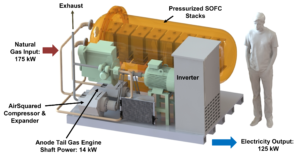

The solid oxide fuel cell (SOFC) stack contains metal-supported SteelCellTM technology, which provides robustness for operation under pressurized conditions and high amounts of internal reforming. The IC engine combusts unused anode tail gas to integrate several BOP functions using engine shaft-mounted, low-speed, scroll-type rotating machinery and groundbreaking inverter technology. Colorado School of Mines and its collaborators, Colorado State University, Kohler Power Systems and Air-Squared Inc., aim to produce an end product similar to the image above.
Testing
The SOFC stacks will be operated at elevated pressures, with an intention to increase efficiency and power density. Led by Dr. Neal Sullivan, the Colorado Fuel Cell Center (CFCC) has developed a rig (see rendering below) to understand pressurization benefits by testing Ceres Power stacks. The gas handling technology has been configured to assure the anode, cathode and vessel volume maintain equal pressure, while the flow temperatures are closely monitored. The pressure vessel’s body and equipment were sized to test the Ceres Power’s 1kWe and 5kWe stacks.
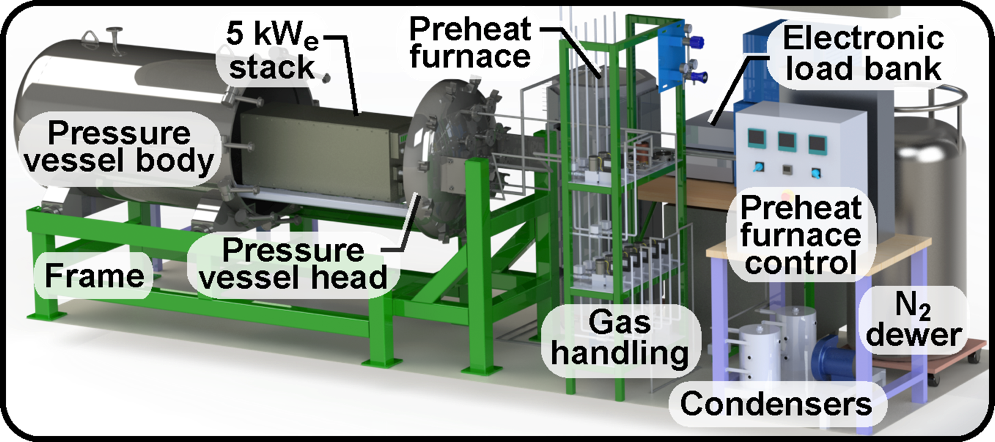
The figure below is of the test stand, ready for operation with a 1kWe Ceres Power stack at the CFCC.
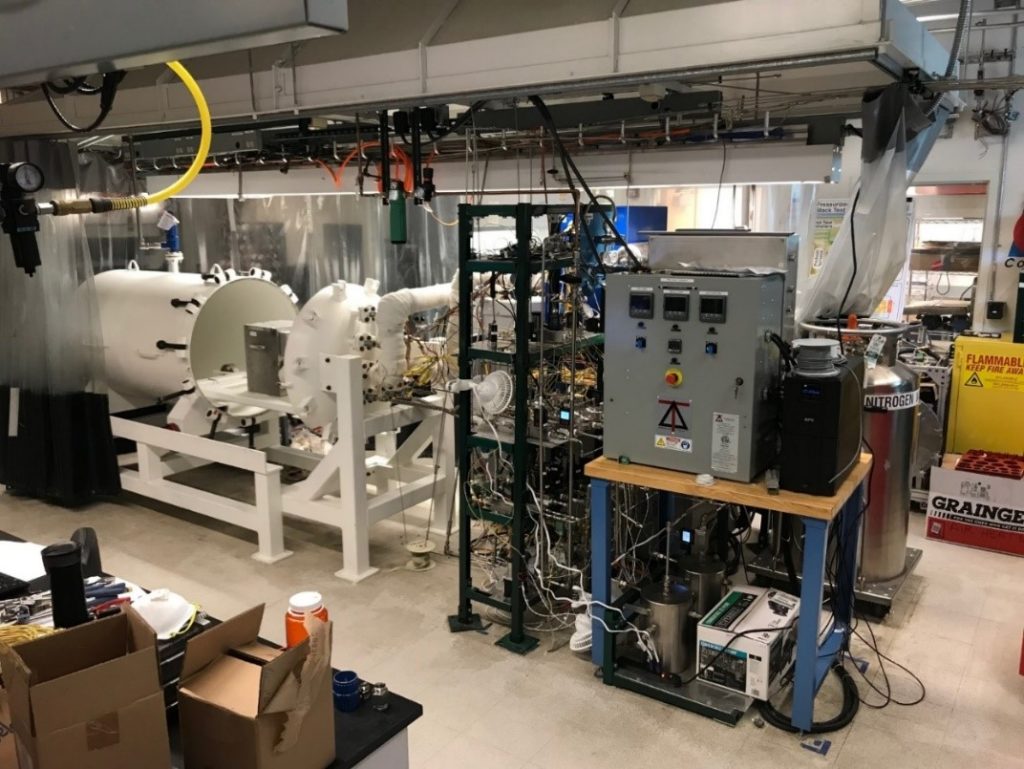
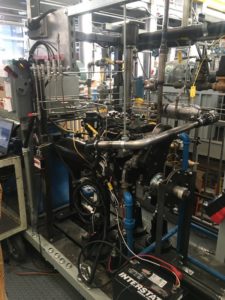
Below are results from the first round of testing with the 1kWe stack. The data supports theoretical performance predictions for a positive pressurization effect on voltage. Mines will be receiving a Ceres 5-kWe stack for the next stage of experiments.
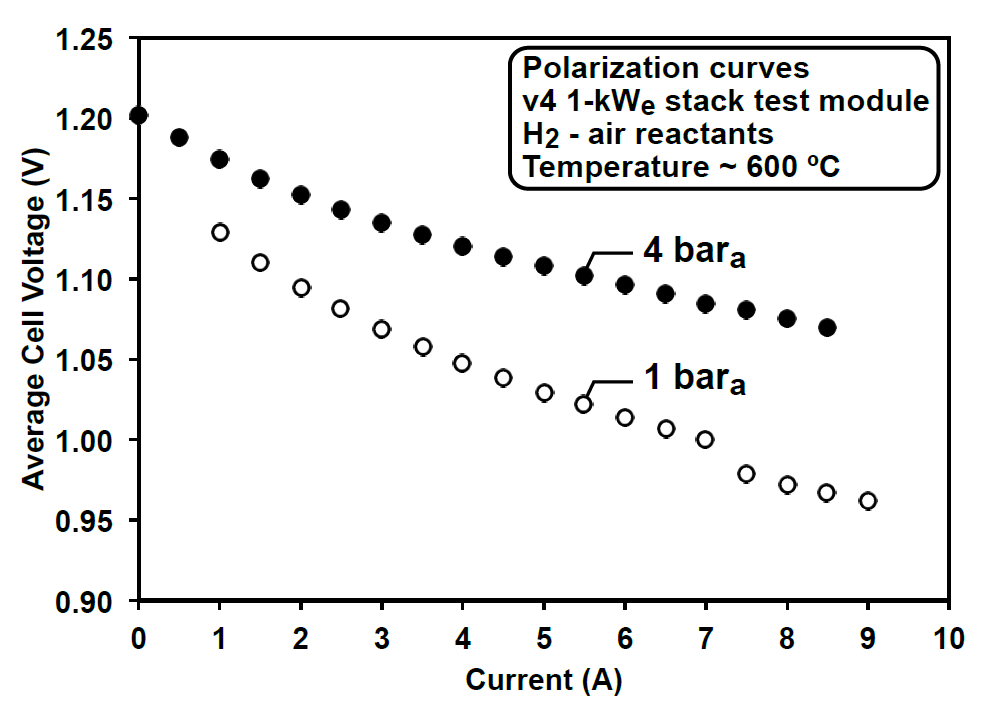
Modeling
Mines produces high-fidelity thermodynamic models in PSE’s gPROMS ModelBuilder® to design and simulate the system. A model for the internal combustion engine, SOFC stack and fuel pre-reformer has been developed and will be validated against test and manufacturer’s data. The figure below is a schematic of the flowsheet, which is a simple representation excluding heat exchangers, bypass lines and other BOP equipment.
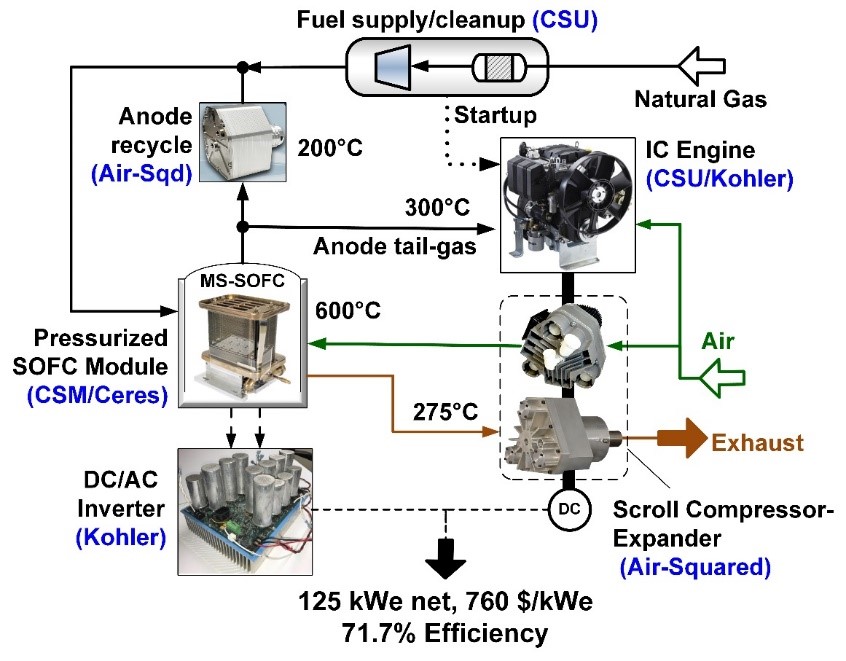
It is anticipated that a successful design of such a system would accelerate the deployment of distributed electricity generation, which would help support the existing electric grid and eliminate losses due to transmission and distribution, while also displacing generation using fossil-fueled generation systems that are less efficient. This project could introduce a paradigm-shift in the fuel cell field by demonstrating that a hybrid fuel cell system, can drive both radically lower costs and increase electric efficiency beyond 70% for small-scale, distributed power generation applications.
FUNDING: U.S. DOE ARPA-E INTEGRATE Program
PI: Robert Braun
Co-PIs: Neal Sullivan, Tyrone Vincent (Mines); Todd Bandhauer, Dan Olsen, Brett Windom (CSU); Robert Danforth (Kohler); Bryce Schaffer (Air-Squared, Inc.)
Graduate Students: David Wahlstrom and James Frazar (MS candidates)
Other Contributors: Dr. Chris Cadigan, Dr. Soren Jensen, Dr. Mayur Mundhwa, and Chris Chmura
PUBLICATIONS
- R.J. Braun, E. Reznicek, C. Cadigan, N.P. Sullivan, R. Danforth, T. Bandhauer, S. Garland, D. Olsen, B. Windom, and B. Schaffer, Development of a Novel High Efficiency, Low Cost Hybrid SOFC/Internal Combustion Engine Power Generator, ECS Transactions, 91(1):355-360, (2019).
Current Projects
Past Projects
Selected Publications in This Research Area
Design of Protonic Ceramic Fuel Cell Systems and Their Potential as a Distributed Power Generator with Electric Efficiencies Exceeding 70% (working paper)
A. Dubois, K. Ferguson, R.J. Braun
Journal of Power Sources, (2020)
Development of kW-Scale Protonic Ceramic Fuel Cells and Systems
R.J. Braun, A. Dubois, K. Ferguson, C. Duan, C. Karakaya, R.J. Kee, … A. Wood
ECS Transactions, 91(1):997–1008, (2019)
Steady-State and Dynamic Modeling of Intermediate-Temperature Protonic Ceramic Fuel Cells
K.J. Albrecht, A. Dubois, K. Ferguson, C. Duan, R.P. O’Hayre, R.J. Braun
Journal of The Electrochemical Society, 166(10):F687–F700, (2019)
R.J. Braun, E. Reznicek, C. Cadigan, N.P. Sullivan, R. Danforth, T. Bandhauer, S. Garland, D. Olsen, B. Windom, B. Schaffer
ECS Transactions, 91(1):355–360, (2019)
Highly Durable, Coking and Sulfur Tolerant, Fuel-Flexible Protonic Ceramic Fuel Cell
C. Duan, S. Ricote, H. Zhu, N. Sullivan, C. Karakaya, R.J. Kee, R.J. Braun, R. O’Hayre
Nature, 557:217–222, (2018)
G. Anyenya, R.J. Braun, K. Lee, N.P. Sullivan, A. M. Newman
Optimization & Engineering, 19:1037–1081, (2018)
A. Dubois, S. Ricote, R.J. Braun
Journal of Power Sources, 369:65–77, (2017)
G.Anyenya, N.P. Sullivan, R.J. Braun
Energy Conversion & Management, 140:247–259, (2017)
G.Anyenya, B. Haun, M. Daubenspeck, R. J. Braun, N.P. Sullivan
ASME Journal of Electrochemical Energy Conversion & Storage, 13(4):041001, (2016)
Readily Processed Protonic Ceramic Fuel Cells with High Performance at Low Temperatures
C. Duan, J. Tong, M. Shang, S. Nikodemski, M. Sanders, S. Ricote, A. Almansoori, R. O'Hayre
Science, 349(6254):1321–1326, (2015)
Modeling Intermediate Temperature Protonic Ceramic Fuel Cells
K.J. Albrecht, C. Duan, R. O’Hayre, R.J. Braun
ECS Transactions, 68(1):3165–3175, (2015)
K. Pruitt, A. Newman, S. Leyffer, R.J. Braun
Optimization and Engineering, 15:167–197, (2014)
K. Pruitt, R.J. Braun, A. Newman
Applied Energy, 102:386–398, (2013)
K. Pruitt, R.J. Braun, A. Newman
Applied Energy, 111:904–920, (2013)
Application of SOFCs in Combined Heating, Cooling and Power Systems
R.J. Braun and P. Kazempoor
Chap. 12 in Solid Oxide Fuel Cells: From Materials to System Modeling, T.S. Zhao and M. Ni, editors, Energy and Environment Series No. 7, Royal Society of Chemistry, Cambridge, U.K. (2013)
View Other Research Areas:
MODELING AND SYSTEMS ANALYSIS OF ALTERNATIVE FUEL PRODUCTION AND UTILIZATION SYSTEMS
RENEWABLES AND GRID-ENERGY STORAGE SYSTEMS